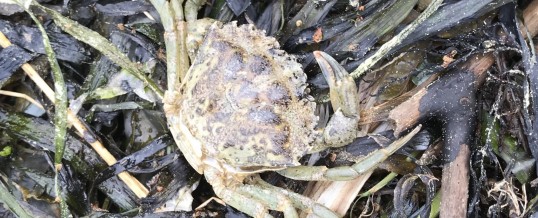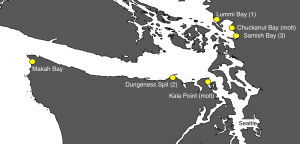
May 8, 2020
Like so many other projects and programs right now, partners contributing to state-wide efforts to manage European green crabs are trying to figure out what can safely be done, in the midst of the global pandemic, to address the urgent threat of invasion. In particular, there has been concern that green crabs won’t wait until COVID-related isolation measures are lifted to continue their population growth and spread, and that we could miss a critical window of opportunity in controlling their populations if we aren’t able to trap right now. Nevertheless, the need for distancing and safety measures at this moment is clear, and safety is everyone’s number one priority.
One of the many benefits of cooperative management has been that some groups have been able to conduct limited field activities over the past few weeks. Management partners, including Washington Department of Fish and Wildlife, US Fish and Wildlife Service, Lummi Natural Resources, Makah Fisheries Department, and Washington Sea Grant, have been staying in touch via Zoom meetings, updating each other on what each group can do, and what we are all seeing. We wanted to provide a brief update on the status of those efforts so far this year.

Inland detection sites of invasive European green crab in Washington to date in 2020. Parentheses denote number of live crabs captured, or detection of a molted crab shell. Click to enlarge.
Crab Team Network
Many teams monitoring with WSG Crab Team have been able to resume sampling, provided they can still access their sites and conduct the protocols under social-distancing guidelines. Even with reduced team sizes, extra administrative hoops to jump through, and masked and gloved, Crab Team crews did a remarkable job monitoring many of the 56 network sites in the network during April. None of the teams captured any live European green crabs in their traps, including at Drayton Harbor (site of a new detection last fall), which is great news! Two Crab Team volunteers, however, did find green crab molts near sites where detections had previously been made – Kala Point and Chuckanut Bay. These findings highlight the value of being able to identify green crabs even if you are only able to walk the beach (more info on how you can get your eyes on the beach).
Dungeness Bay
US Fish and Wildlife Service has been able to resume removal trapping in April. Even without their usual corps of dedicated volunteer, staff have been putting in an incredible amount of effort and set more than 525 traps over just the past few weeks. So far, they have captured only two green crabs. For reference, by this time last year, they had captured 32 crabs in about 700 traps.
Samish Bay
Of the eight total detections along inland Washington shorelines to date in 2020, three came from Samish Bay in March and April, all from shellfish growers working on Taylor Shellfish’s beds. Following detection of 11 crabs in Samish Bay over 2019, growers working for several companies have stepped up surveillance, and are setting a small number of traps around operations where green crabs have popped up. This type of monitoring will hopefully inform what we know about how green crabs move across different habitat types, and how they might impact shellfish operations.
Lummi Bay
One of the most concerning new green crab populations to be detected last year was in Lummi Bay, where Lummi Natural Resources (LNR) detected crabs for the first time in two hot spots during fall. LNR resumed trapping efforts in these hotspots over the past month, and so far has only captured a single green crab.
What do we make of this?
Where trapping is being conducted, the pattern of low green crab catch rates (average number of crabs caught per trap) is repeated across multiple sites. Even considering that none of the partners are able to launch full scale efforts, this is somewhat reassuring news. At Dungeness Spit, we have robust data back through 2017; this is the lowest capture rate for this time of the season for all four years. Just outside the Strait of Juan de Fuca in Makah Bay, the Makah Fisheries Department has also noted the past few weeks have yielded lower green crab trap rates than this time last year.
While it would be lovely if this suggested to us that there were no more green crabs out there, that they had succumbed to some mysterious stressor over the winter, or that we actually did trap almost every single one last year – and we can assure that latter scenario is extremely unlikely – it’s quite possible that this year is a “slow” year for marine critters to get rolling, biologically speaking. We see this, too, in Crab Team sampling: the rate at which native species were found in traps in traps appears to be lower for last month than a year ago.
We will all learn more over the next month or so. As spring progresses and warmer days remind us that, in spite of how we might feel, the earth is still moving around the sun and catch rates may very well increase. But there’s some solace to be taken in the possibility that April 2020 offered us a bit of a grace period for green crab management work. Perhaps a slow start has given us much-needed time to strategize about how to adapt our plans for management this year. While nothing is certain about what the next several months will look like, the work we have all been doing over the last month nevertheless positions us all to take advantage of the time and opportunities we do have.
–Emily Grason
Header photo courtesy of Chris Brown
MAY
2020